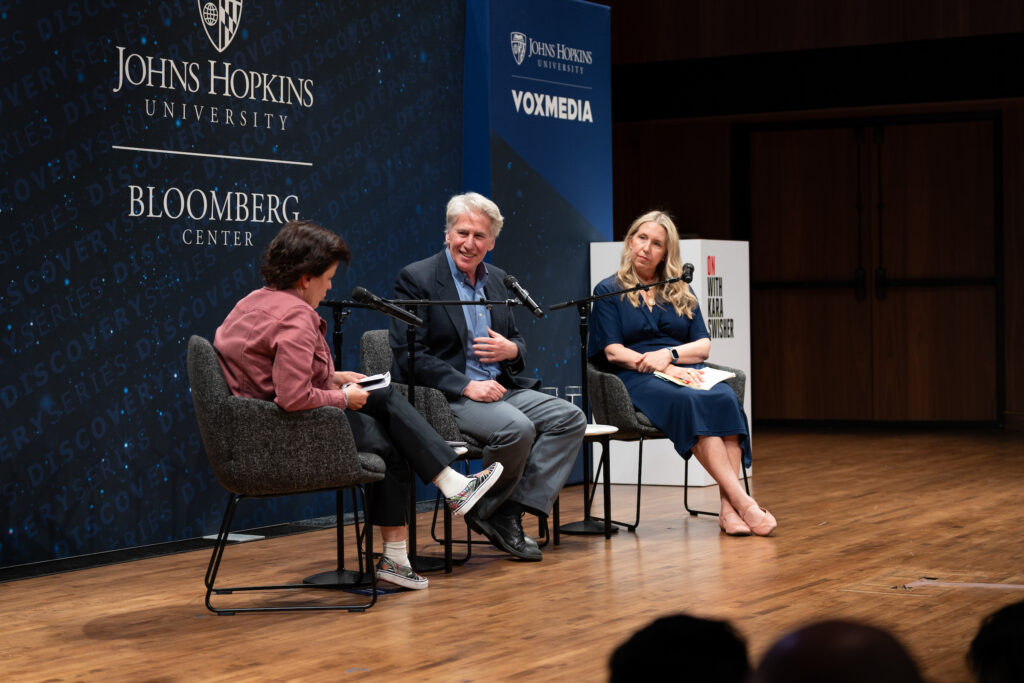How university research lays the foundation for major tech innovations
While tech companies usually get the credit for pioneering new tech, many innovations wouldn’t be here without initial university discovery.

Whether you’re starting a Google Maps navigation to an off-site business meeting or hailing a Waymo self-driving car to take you back to the office, you’re using technology that can be traced back to university research.
While major tech innovations are usually attributed to the private sector, big companies often market products that are only possible because of foundational university research. From GPS tech to autonomous vehicles, academic institutions have paved the way for some of the world’s most impactful inventions.
Now, as the AI race underscores the importance of quick and groundbreaking tech discoveries, Christy Wyskiel, executive director of Johns Hopkins Technology Ventures, joined Gary Rivlin, author of AI Valley, for a live recording of tech podcast On with Kara Swisher at the Johns Hopkins University Bloomberg Center. They discussed private and public funding for AI research and development and how universities continue to serve as the backbone of private sector innovation and economic growth while adapting to present-day needs and challenges.
Backstory: Previous university-driven innovations
Technological breakthroughs don’t happen overnight; they’re the result of layers of discoveries that culminate in a specific product or service the public can access. That first layer often originates at universities, as it has with several modern inventions.
Self-driving cars. Beginning with Carnegie Mellon University in the ‘80s and ‘90s, the theoretical backbone, technical innovation, and workforce pipeline that enabled autonomous vehicles came from academic institutions. From the University of Michigan’s test facility to MIT and Stanford’s published papers on the ethics and morals of self-driving cars, universities supported both the R&D as well as the safety protocols and legal frameworks for this emerging technology.
Private companies like Uber also ended up recruiting researchers from some of these institutions and establishing research facilities on some of their campuses to advance innovation in a market that could generate $300 billion to $400 billion in revenue by 2035. This demonstrates the societal and economic ripple effects of university discoveries.
GPS. Everyday systems like Google Maps and Find My rely on foundational geo-location technology that originated in a publicly funded research setting. In fact, the initial concept of satellite navigation using the Doppler effect was developed by scientists at the Johns Hopkins Applied Physics Laboratory (APL) in the 1950s. This led the Advanced Research Projects Agency (ARPA) to develop the first global satellite navigation system in 1958 before the U.S. Department of Defense initiated the GPS project in 1973 that eventually became publicly available in the ‘80s.
Core AI functions. While major tech players like OpenAI and DeepSeek come to mind when we think of AI innovation, two core AI concepts—neural networks and machine learning—came from work university researchers did back in the ‘80s. Just last year, researchers John J. Hopfield and Geoffrey Hinton received the Nobel Prize in Physics for their groundbreaking work in artificial neural networks, which are integral to AI functionality for medical imaging, self-driving cars, and financial forecasting.
This university-to-private-sector pipeline, while not new, is often overlooked. Still, it continues to evolve today, especially as innovation behind artificial intelligence becomes a central focus of U.S. national security. To stay ahead, universities are adapting.
How university research promotes innovation today
Innovation, economic growth, and national competitiveness require universities, government, and the private sector to work together. Universities may have historically done the early work, but Wyskiel said they must stay embedded in the process to provide an incentive for discovery aside from profitability.
“I think there has to be a combination of thinking about the products, the returns, and also the policy,” Wyskiel said of helping the next generation of entrepreneurs innovate in the AI sector.

That may take the form of universities licensing new technology to private companies to get innovations to the public more quickly, she said. This allows academic institutions to retain royalties while companies grow sales, a collaborative approach that benefits both parties as well as the public.
Lisa Su, CEO of semiconductor company Advanced Micro Devices (AMD), echoed the need for cross-sector collaboration to keep the U.S. at the forefront of tech innovation.
“It includes work that we have to do in the private sector, it includes work that we have to do at universities, it includes work that we have to do in national labs,” she said in a separate conversation with podcast host Kara Swisher at the Hopkins Bloomberg Center. “All of these things are important, and of course, we want to do it as efficiently as possible. We all know that there are efficiencies to be gathered, but fundamentally, university research is very important.”
How funding affects the real-life impact of tech innovation
Initial discovery takes time—often decades—and resources, and it’s impossible to predict the return on research investment early in the process. This makes fundamental research difficult for the private sector—aside from big tech companies—and perfect for universities.
And this work can change lives. Today, researchers are working on ways to leverage AI to detect life-threatening diseases like pancreatic cancer earlier, Wyskiel said. They’re also developing practical applications for AI, such as a mobile application to diagnose strep throat and spare parents unnecessary trips to urgent care or the hospital.
But discoveries like this require funding—funding dedicated to research for its own sake.
As the Trump administration cuts hundreds of research grants to universities, Rivlin said the damage could have resounding effects that a future new administration can’t easily repair.
“Cutting off basic research to universities … is so short-sighted,” Rivlin said. “That’s our magic formula in this country; that’s our secret sauce. The Chinese have said by 2030 they want to be dominant in AI, and if we’re cutting off this basic research, I think we’re giving them a big advantage.”
Wyskiel agreed, noting that it could stunt progress by stunting talent.
“My greatest fear is for this incredibly talented generation of scientists that are going to choose necessarily not to do that work if their grant funding is cut off,” she said. “If they’re unable to continue their work, they’ll go do something else, and what does that mean for the next decades of that type of progress?”